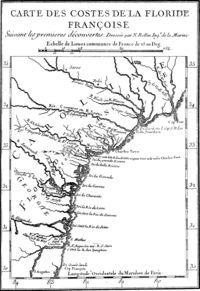Spanish assault on French Florida
| Action of September 1565 | |||||||
|---|---|---|---|---|---|---|---|
| Part of French colonial conflicts | |||||||
 Image of French settlement in Florida in 1562. |
|||||||
|
|||||||
| Belligerents | |||||||
|
|
|
||||||
| Commanders and leaders | |||||||
|
|
|
||||||
| Strength | |||||||
| 49 ships (including merchant ships) | 33 ships | ||||||
| Casualties and losses | |||||||
| 1 admiral, 700 men | |||||||
The Spanish assault on French Florida began as part of imperial Spain's geopolitical strategy of developing colonies in the New World to protect its claimed territories against incursions by other European powers. From the early 16th century, the French had historic claims to some of the lands in the New World that the Spanish called La Florida. The French crown and the Huguenots led by Admiral Gaspard de Coligny believed that planting French settlers in Florida would help defuse religious conflicts in France and strengthen its own claim to a part of North America. The Crown wanted to discover and exploit valuable commodities, especially silver and gold, as the Spanish had done with the mines of Mexico and Central and South America. The political and religious enmities that existed between the Catholics and Huguenots of France resulted in the attempt by Jean Ribault in February 1562 to settle a colony at Charlesfort on Port Royal Sound, and the subsequent arrival of René Goulaine de Laudonnière at Fort Caroline, on the St. Johns River in June 1564.
The Spanish regarded the destruction of Fort Caroline as necessary to the security of their colony at St. Augustine, the first permanent European settlement in what is now the United States. By the doctrine of uti possidetis de facto, or “effective occupation", they legitimized their claim to Florida, stretching from the Panuco River on the Gulf of Mexico up the Atlantic coast to Chesapeake Bay, leaving England and France to establish their own colonies in regions farther north.
Jean Ribault founded his colony at Port Royal in 1562, having previously come upon the St. Johns, which he called la Rivière de Mai (the River of May), because he saw it on the first of that month. Two years later, in 1564, Laudonnière landed at the Indian town of Seloy, the site of present-day St. Augustine, Florida, and named the river la Rivière des Dauphins (the River of Dolphins) after its plentiful dolphins; moving north, he established a settlement at Fort Caroline on the south side of the St. Johns, six miles from its mouth.Philip II of Spain, who regarded the possession of Florida as necessary for the safety of Spanish commerce, hearing that Ribault, who had returned to France, was organizing another expedition for the relief of his colony of Huguenots across the Atlantic, determined to assert his claim to the possession of Florida on the ground of prior discovery, and root out the French at all costs.Pedro Menéndez de Avilés had already been authorized to settle there, and his force was increased to enable him first to expel the French.
...
Wikipedia
